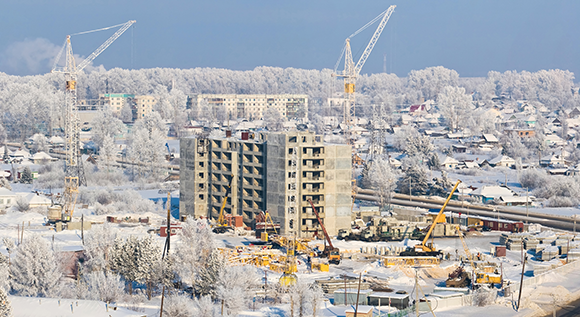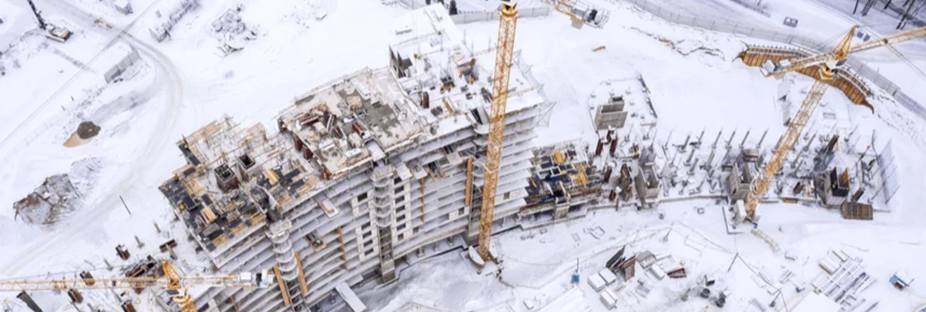In the second of our two-part series on staying safe in the winter, we’ll look at personal safety – what you can do to keep you and your team safe during these colder months. Doing so can help you maintain your productivity and reduce your chances of illness and injury. Read these tips to ensure you have a healthy winter so that you (and your crew) are prepared for your spring projects.
It’s not a stretch to say that most people would rather skip through the winter months if they could. Still, since there’s no remote control to fast-forward through time, the best defense against America’s least productive season is to be prepared, especially in the construction industry.
Safety is always a priority for construction workers, but when temperatures drop and ice covers everything, there are two main rules for staying safe in winter: be aware and be prepared.
With that in mind, here are five simple but often overlooked actions you can take to protect yourself and others on the job site this season.
Be Aware
Watch the Weather
A sudden temperature rise can turn ice into water; stronger winds can affect balance or visibility. Even small weather changes can create new hazards, contributing to on-site increases in workplace injuries and even fatalities.
1% of construction workers are injured each year badly enough to miss work. In fact, falls, slips, and trips continue to be the leading cause of death in construction workers today.

That’s why, according to the U.S. Bureau of Labor Statistics, it’s important to check the weather not just once in the morning but throughout the day. Many people glance at the daily forecast before heading out, but few will check again as conditions change.
Consider installing a weather app that provides hourly, regional updates. Many free apps work without Wi-Fi and offer adjustable notification settings.
Know the Signs of Cold Stress
According to the Occupational Safety and Health Association (OSHA), cold stress occurs when the skin and, eventually, the internal body temperature lose heat, leaving the body unable to warm itself. This can lead to possible injuries, tissue damage, or death.
There are four main types of cold stress: hypothermia, frostbite, trench foot, and chilblains. Each type has different symptoms, but some common early signs include:
- Shivering
- Fatigue
- Loss of coordination
- Confusion and disorientation
- Numbness
- Tingling or stinging sensations
- Swelling or redness of the skin
- Possible blistering
At the first sign of these symptoms, it’s critical to alert your supervisor and request medical assistance. It’s also important to be attentive to co-workers showing any signs of cold stress and, if necessary, encourage them to seek help.
Be Prepared
Layer Like a Pro
Layering is more than just piling on a boxful of bulky clothes. Multiple layers of thin material are better at retaining warmth than several heavy items.
Each layer should serve a specific purpose, fit properly, and be made of different materials.
- Base-layer – Wool or polyester. It should fit snugly but not too tight to wick sweat away from your body.
- Mid-layer – Fleece or down. It should fit loosely but not be too baggy, which will trap body heat and prevent warmth from escaping.
- Outer-layer – Breathable, windproof, and/or waterproof material. It should fit snugly but not tight as a protective shell against moisture and wind.
Here Comes the Sun
Glare is worse in the winter! The sun is lower in the sky, and snow or ice reflects more light, making it harder to see when the risk of slipping or falling is higher than usual.
Also, UV rays are as harmful in the winter as in the summer, especially at high altitudes.
Finally, exposure to strong winds for a long time can irritate and make your eyes water, which can blur your vision on a job site and increase your risk of injury.
This makes it even more important for workers to wear their personal protective equipment (PPE) in the winter. Another study by the U.S. Bureau of Labor Statistics shows that about 62% of construction workers work at heights, but only 31%—about half—wear the right PPE.
Don’t Skip Snack Time
Less sunlight in winter can make us feel more tired, especially since construction workers can burn as much as 1,000 calories (about 80 minutes of running) in one hour. Planning snacks throughout the day can help to improve your stamina and concentration, reducing the chances of winter-related accidents.
Eating small amounts of food every 3-4 hours is highly recommended. Try to pick snacks that have about 125-130 calories (about 10 minutes of running) apiece.
Choose high-fiber, protein-rich foods and healthy carbohydrates, such as:
- Trail mix (with nuts, seeds, and dried fruit)
- Protein bars
- Hard-boiled eggs
- Fresh fruits
- Yogurt
- Hummus
It’s also very important to stay hydrated! Dehydration is more challenging to notice in winter because people tend to feel less thirsty when it’s cold outside.
Go Health Urgent Care states that warm liquids, such as herbal tea and broth, are excellent hydration sources in cold weather. In addition, try to limit caffeine intake by choosing decaf coffee or herbal teas.
Following these suggestions won’t make the cold leave any faster, but they may help in the struggle to weather the elements and stay safe until spring arrives.
Winter can also be an expensive time of year for many construction businesses, too, so make sure to read the first article in our safety series about how to safeguard your business’ budget.
